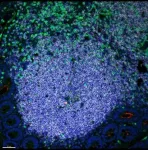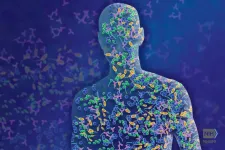(Press-News.org) A human genetic mechanism hijacked by SARS-CoV-2, the coronavirus behind the COVID-19 pandemic, to help it spread also makes it vulnerable to a new class of drug candidates, a new study finds.
Led by researchers at NYU Grossman School of Medicine, a research team showed that coronavirus reproduction in infected human cells requires chemical changes made by the human protein METTL3 to RNA, a key form of genetic material. Additional human proteins involved in the recognition of modified RNA, YTHDF1 and YTHDF3, were also found to be important to the process.
Published online in Genes and Development on June 24, the study showed for the first time that a molecular inhibitor of METTL3, designed by Storm Therapeutics Ltd and called STM2457, dramatically reduced in cell cultures the replication of both pandemic SARS-CoV-2 and, a less severe, seasonal coronavirus, HCoV-OC43, one cause of the common cold.
"Our results represent the first time a chemical inhibitor of METTL3 has been shown to have an anti-viral effect for coronaviruses, or any virus," says senior study author Ian Mohr, PhD, professor in the Department of Microbiology at NYU Langone Health. "This represents a necessary step in drug development, identifies new targets, and reveals an unexpected strategy to halt the coronavirus lifecycle."
Turning Virus' Weaknesses Against Them
The current study builds on a growing understanding of gene regulation. It has long been established that sequences of As, Gs, Cs and Ts, the molecular letters in the DNA code of genes, are copied into messenger RNA (mRNA) molecules that carry the information to the machinery that determines which proteins are made. Only recently has the importance of chemical modification to mRNAs become apparent in the control of protein production. In some instances this process is controlled by the attachment of a methyl group (one carbon and three hydrogens) to an RNA chain, which turns that genetic message off.
Crucially, coronaviruses that replicate inside human cells are known to encode the complete set of their genetic instructions (their genomes) in RNA chains, raising the question of whether human RNA modification enzymes, including those that attach methyl groups, could impact the production of viral proteins that enable them to multiply.
Past work in Mohr's lab had revealed the enzymes that determine whether an A (adenosine), one of the chemical "letters" making up mRNA, is methylated at the N6 position (m6A) is important for replication of human cytomegalovirus (HCMV), with regulation by human m6A enzymes of mRNAs shaping the immune response to that virus.
In the current study, the research team showed for the first time that the reproduction of SARS-CoV-2 and HCoV-OC43 requires the action, not only of the human enzyme that installs the m6A methylation on RNA, METTL3, but human proteins that bind to this unusual arrangement of methylated RNA, YTHDF1 and YTHDF3. Remarkably, the researchers also found that the RNA genomes of both study coronaviruses contained this m6A modification.
For the next step, the NYU Langone team partnered with the UK-based Storm Therapeutics, which had run a medicinal chemistry program to develop a compound that best inhibited the action of METTL3. The current study compared the effects of the METTL3 inhibitor STM2457 and an inactive control compound, STM2120, on cultures of human lung cells infected with the seasonal coronavirus or SARS-CoV-2. The researchers then used an imaging technology to track viral infection in thousands of cells treated with different doses of STM2457.
Compared with the same concentration of the inactive control compound, the highest dose of STM2457 reduced the number of HCoV-OC43 infected cells in culture by more than 80 percent, while the same dose of STM2457 reduced SARS-CoV-2 reproduction by more than 90 percent. Further experiments revealed that STM2457 reduced viral RNA and protein levels, but not by affecting the same human immune response mRNAs previously found to be important for HCMV.
"The inhibition of coronaviruses by this molecule is really encouraging but understanding exactly why coronaviruses need m6A RNA modification is important and might enable the design of compounds that work even better," says study first author Hannah Burgess, PhD, an assistant research scientist in the Department of Microbiology at NYU Langone Health.
Moving forward, the research team plans to further investigate precisely how m6A modification influences virus and host gene expression in cells infected with pandemic or seasonal coronaviruses and whether STM2457 can interfere with coronavirus replication and prevent severe disease outcomes in non-human animals.
"We went into it hoping to learn about the differences between the biology of innocuous and pandemic coronavirus infections," says co-corresponding author Angus Wilson, PhD, associate professor in the Department of Microbiology at NYU Langone Health. "If anything we found that both share a dependence upon the m6A methylation machinery. That creates the hope that inhibiting METTL3 may also be useful against future pandemic coronaviruses."
INFORMATION:
Along with Mohr, Burgess, and Wilson, study authors at NYU Langone Health were Letitia Thompson, Puthankalam Srinivas Kalanghad, Rebecca Grande, Elizabeth Vink, and Kenneth Stapleford in the Department of Microbiology; along with Daniel Depledge and Jonathan Abebe in the Department of Medicine. Also authors were Wesley Blackaby, Alan Hendrick, and Mark Albertella at Storm Therapeutics Ltd, of Cambridge, United Kingdom, and Tony Kouzarides at The Gurdon Institute and Department of Pathology, University of Cambridge, in Cambridge.
The study was supported by National Institute of Allergy and Infectious Diseases grants AI152543, AI073898, AI151358, National Institute of General Medical Sciences grant GM056927, National Institutes of Health grants T32 AI100853 and T32 AI007180, and Perlmutter Cancer Center Support Grant P30CA016087.
Hospitalizations to treat pediatric gun injuries are expensive, and U.S. taxpayers and the poor are bearing the price, according to a new study from the Stanford University School of Medicine.
The study, which published online June 23 in PLOS ONE, found that the average cost of an initial hospitalization for a pediatric firearm injury is around $13,000. A total of about $109 million is spent on such hospitalizations in the country each year. The figures do not capture the total costs of rehabilitating young gunshot victims, which can be much higher.
Research into the financial, health and social costs of firearm injuries in the United States has focused mostly on adults, said the study's senior author, Stephanie Chao, ...
In a groundbreaking study, a team of UC Davis researchers has discovered a special type of stem cell that can reduce the amount of the virus causing AIDS, boosting the body's antiviral immunity and repairing and restoring the gut's lymphoid follicles damaged by the simian immunodeficiency virus (SIV), the equivalent of the human immunodeficiency virus (HIV) in non-human primates. ...
Adult corals that survive high-intensity environmental stresses, such as bleaching events, can produce offspring that are better suited to survive in new environments. These results from a series of experiments conducted at the Bermuda Institute of Ocean Sciences (BIOS) in 2017 and 2018 are deepening scientists' understanding of how the gradual increase of sea surface temperatures and other environmental disturbances may influence future coral generations.
Researchers on the project included BIOS marine ecologists Samantha de Putron and Gretchen Goodbody-Gringley (now with the Central Caribbean Marine Institute), ecophysiologist Hollie Putnam at the University of Rhode Island (URI), and Kevin Wong, then ...
WACO, Texas (June 23, 2021) - When an organization supports its employees who choose to adopt children, the employees, their families, the adopted children and the organization itself experience positive benefits and outcomes, according to new research from Baylor University.
The study, "It Takes a Village: How Organizational Support for Adoption Positively Affects Employees and Their Families," is published in the Journal of Occupational and Organizational Psychology. Researchers from Baylor's Hankamer School of Business include Matthew J. Quade, Ph.D., associate professor of management; ...
FOR IMMEDIATE RELEASE
STUDY SUGGESTS THAT SMOOTHER SILICONE BREAST IMPLANTS REDUCE SEVERITY OF IMMUNE SYSTEM REACTIONS
According to researchers at Johns Hopkins Medicine, the Massachusetts Institute of Technology (MIT) and Rice University in Houston, silicone breast implants with a smoother surface design have less risk of producing inflammation and other immune system reactions than those with more roughly textured coatings. Results of the experiments using mice, rabbits and samples of human breast tissue advance knowledge of how the body responds to such implants, providing new information to physicians and affirming ...
PHILADELPHIA - Researchers have been investigating the potential health-promoting qualities of extra virgin olive oil (EVOO) for decades, including its possible medicinal value for preventing cancer, Alzheimer's, and cardiovascular disease, as part of the well-known Mediterranean diet. However, consumers in the U.S. have been slow to embrace it as a staple in their diet. This reluctance, say scientists, might be in part due to EVOO's bitter taste and pungency, which is caused by the presence of substances known as phenolic compounds, the very ones believed to contribute to EVOO health benefits. In 2005, researchers from the Monell Chemical ...
Microscopy is an essential tool in many fields of science and medicine. However, many groups have limited access to this technology due to its cost and fragility. Now, researchers from the Universities of Göttingen and Münster have succeeded in building a high-resolution microscope using nothing more than children's plastic building bricks and affordable parts from a mobile phone. They then went on to show that children aged 9-13 had significantly increased understanding of microscopy after constructing and working with the LEGO® microscope. Their results were published in The Biophysicist.
The researchers designed ...
New York, NY--June 23, 2021--A challenging frontier in science and engineering is controlling matter outside of thermodynamic equilibrium to build material systems with capabilities that rival those of living organisms. Research on active colloids aims to create micro- and nanoscale "particles" that swim through viscous fluids like primitive microorganisms. When these self-propelled particles come together, they can organize and move like schools of fish to perform robotic functions, such as navigating complex environments and delivering "cargo" to targeted locations.
A Columbia Engineering team led by Kyle Bishop, professor of chemical engineering, is at the forefront of studying and designing the dynamics of active colloids powered by chemical reactions ...
A new study published in Nature Communications finds that piles of sand grains, even when undisturbed, are in constant motion. Using highly-sensitive optical interference data, researchers from the University of Pennsylvania and Vanderbilt University present results that challenge existing theories in both geology and physics about how soils and other types of disordered materials behave.
Most people only become aware of soil movement on hillsides when soil suddenly loses its rigidity, a phenomenon known as yield. "Say that you have soil on a hillside. Then, if there's an earthquake or it rains, this material that's apparently ...
WHAT:
National Institutes of Health scientists and their collaborators have identified an internal communication network in mammals that may regulate tissue repair and inflammation, providing new insights on how diseases such as obesity and inflammatory skin disorders develop. The new research is published in Cell.
The billions of organisms living on body surfaces such as the skin of mammals--collectively called microbiota--communicate with each other and the host immune system in a sophisticated network. According to the study, viruses integrated in the host genome, remnants of previous infections called endogenous retroviruses, can control how the host immune system and the microbiota ...





